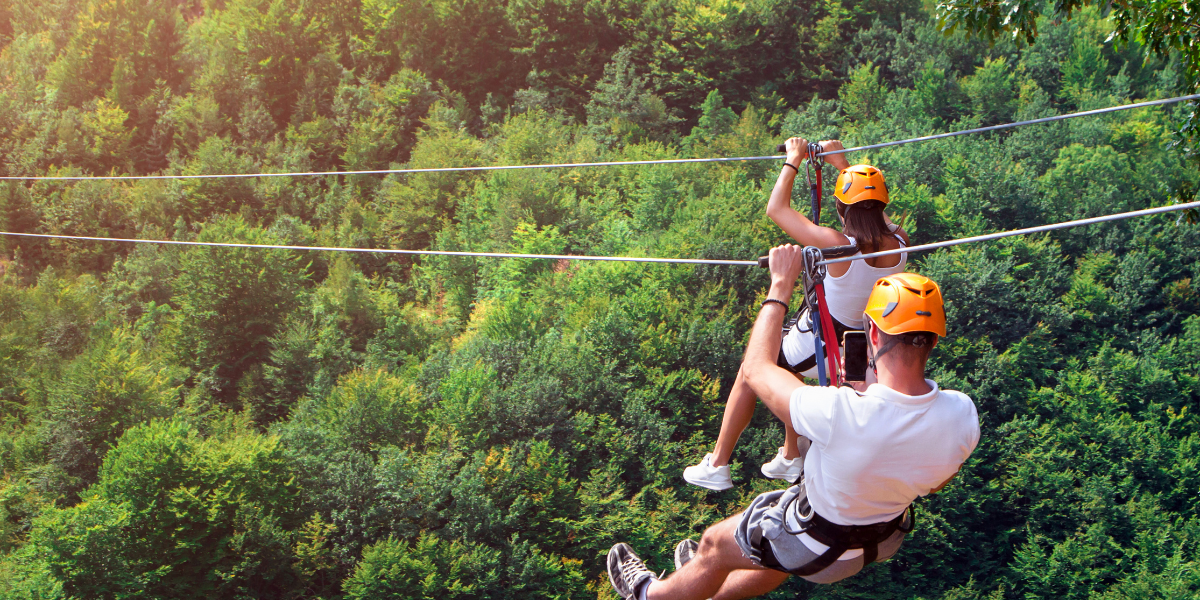Adventure businesses need careful planning and attention to detail. These methods will help you run your adventure business efficiently. These steps include defining your niche, conducting market research, creating a comprehensive business plan, obtaining permits and licenses, hiring the right people, investing in quality equipment, marketing your business, focusing on customer service, and continuously evaluating and improving operations. These measures will help you develop a solid reputation and customer base and continue your firm.
Running an adventure business is thrilling and difficult. However, careful planning, attention to detail, and customer-focused execution can help you develop a solid reputation and customer base and continue your firm. These methods will help you run your adventure business efficiently.
- First, choose your adventure activities. This will let you focus on building a good reputation and consumer base. Research your rivals and target market to see what they want from an adventure business. Use this data to create a distinct selling proposition and find ways to stand out.
- Create a detailed business plan with goals, strategies, marketing, and operations. This will help you prioritize and sustain your business. Your adventure business needs permits, licenses, and insurance.
- Hire adventurers with the skills and experience to give excellent customer service. To protect consumers and staff, buy high-quality, routinely examined equipment.
- Create an online-offline marketing plan. Social networking, email marketing, and other digital marketing methods can reach potential customers. Consider partnering with nearby hotels, restaurants, and other companies to promote your services.
- Make every customer happy with excellent service. Encourage consumer feedback and immediately address issues. Review your business procedures and make improvements to increase efficiency and client happiness. Follow industry trends and look for new business prospects.
An adventure business demands careful planning and attention to detail. Following the suggestions below will help you create a solid reputation and client base and sustain your business.
Find Your Adventure: Defining Your Niche for a Thriving Business
Starting an adventure business requires defining your niche. You may establish a distinctive, sustainable firm by focusing your efforts, resources, and marketing methods on your target market. Identifying your passion, investigating the industry, assessing your talents and resources, and developing your USP can help you find your niche. These characteristics might help you define your specialization and build your adventure business.
Defining your specialization is the first step to starting an adventure business. By doing so, you may differentiate yourself from competition, target your ideal consumers, and develop a sustainable business. These steps will help you find your specialty and launch your adventure business.
First, decide what adventure sports you love. Starting a business takes time and work, therefore you must find your passion to succeed. Find your passion to start a business that matches your ideals.
The second step is to explore local adventure activities and your competitors. This study will reveal popular activities, target client interests, and competitors. This data can help you adjust your products to customer needs and stand out from competition. Third, identify your target market by age, gender, income, interests, and geography. This stage will reveal your consumers' adventure activity preferences and price points. By determining your target market, you can adjust your marketing messages and products to their needs.
The fourth phase is to assess your abilities, expertise, and resources and consider how to use them to start and maintain an adventure business. Knowing your skills and limitations will help you choose the right business resources. The fifth step is to establish what makes your business different from your competition. Your business's USP will attract clients. Your activities, client service, or unique experience might be this.
Finally, consider your long-term business goals and how your specialty will help you reach them. Understanding your long-term goals will help you make decisions that match your vision and establish a sustainable firm. Beginning an adventure business requires defining your niche. Follow these steps to understand your specialty and build your business. Build a successful adventure business by targeting your ideal consumers, differentiating yourself from competition, and offering unique and thrilling experiences.

Mapping Your Adventure Business Success: Mastering Market Research
Market research is essential to starting an adventure business. Market research reveals your target audience, competition, and service demand. Market research may help you make business decisions, find possibilities, and grow your adventure business. This book will help you perform market research by setting your objectives, acquiring data, analyzing it, reviewing your findings, and updating your research.
Adventure entrepreneurs must conduct market research. Market research can reveal your target market, competition, and service demand. Market research steps are here.
Set research goals first. Decide what information and questions you need. This will help you focus your investigation and obtain the necessary facts.
Data collection follows. Secondary and primary research can yield data. Secondary research uses government statistics, industry publications, and online searches. Primary research uses customer surveys, focus groups, and in-person interviews.
Analysis follows data collection. Analyze your data to find trends, opportunities, and insights about your target market and competition. This stage will help you understand your competition and find market gaps.
Evaluate your data analysis. Use the results for business decisions. For instance, if a certain adventure activity is in high demand, you may wish to offer it.
Finally, market conditions and customer tastes can change. To understand your target market and competition, update your research periodically. Researching the market can help you position and build your adventure business.
Adventure Business Blueprint: Crafting Your Roadmap to Success
A good business strategy is essential to starting and operating an adventure business. Business plans outline goals, strategies, and paths to success. From market study to financial projections, we'll cover the important phases in establishing a complete adventure business plan in this article. A good business plan will help you get finance, stay on track, and succeed.
An adventure park featuring a ropes course and zipline needs a good business plan. This business plan will outline your goals, strategy, and success steps. Creating an Adventure Business plan involves these steps:
Start with an Executive Summary that describes your Adventure Business, including its mission, structure, and products and services. Market Analysis: Describe your target market's needs, wants, and preferences. Discuss market size, trends, and competition. Knowing your market will assist you discover your business's strengths and shortcomings and create better success plans.
In the Product and Service Offerings section, list adventure activities like Ropes Course and Zipline. Explain how your Adventure Business will differentiate itself from others. In the Marketing and Sales Strategy section, describe your audience, positioning, and promotions. This will help you connect with clients and market your firm to its full potential. In the Operations Plan, describe your Adventure Business's organization, procedures, and processes. This section will teach you how to run your business efficiently and manage resources. Financial Projections should include income, balance, and cash flow statements. The financial area will show you your Adventure Business's costs and profitability.
Appendices should contain resumes, licenses, and insurance information. Creating a company strategy is one-time, but reviewing and revising it often is crucial. Updating your strategy can help you stay on track and respond to changing market, business, and goal conditions. A solid business plan can help you fund and grow your Adventure Business.
Business plans must be reviewed and updated often. Update your strategy to stay on track and react to changing market, business, and goal conditions. A solid business plan can help you fund and grow your Adventure Business.

Unlocking Adventure: The Legal Requirements for Starting Your Business
Starting an adventure business is exciting and lucrative, but it requires permissions and licensing. Business requirements depend on region and type. This handbook covers business registration, local and state licenses, and safety laws. For your adventure business's permits and licenses, speak with pros.
Starting an adventure business might be fun, but it has numerous legal restrictions. Starting an adventure business requires permits and licenses. Follow these general procedures to make sure your adventure business is legal.
Your adventure business structure will decide the licenses and licenses you need. File paperwork with the state to register your adventure business. Tax identification requires a business tax ID number. Local and state permits may be required for your adventure business. Rock climbing and rafting may require a state license for your adventure business. Liability insurance protects your business from adventure activity incidents.
Your adventure business's location may require permissions for camping, rock climbing, and public land use. To protect your customers, follow all safety rules.
Finally, renew licenses and permits as needed and follow all rules and regulations. To guarantee your adventure business has all the essential permits and licenses, consult a lawyer or tax professional. You can keep your adventure business lawful and secure by following the law.
Staffing for Adventure: Tips for Hiring the Right Team
Adventure businesses need the right staff. Hires can improve customer service, safety, and growth. However, bad hires can cause customer unhappiness, accidents, and employee attrition. Here are some ways to find, screen, and keep adventure company personnel.
Any adventure business needs the correct staff. Your staff must deliver excellent service and satisfy customers. Follow these steps to hire the right people:
First, determine your adventure business's guide, teacher, support, and administrative needs. Once you determine the jobs you need to fill, write comprehensive job descriptions that define the tasks, credentials, and experience needed for each. Next, post openings on job boards, social media, local newspapers, and industry groups. To verify top candidates' expertise and skills, thoroughly review applications and cover letters, conduct extensive interviews, and check references.
Since adventure business personnel work in close quarters and difficult situations, personality and fit are key. Train the right applicants on your company's policies, processes, and safety protocols. To retain top talent, offer competitive pay and perks. Create a collaborative, open, and customer-focused workplace. This boosts job satisfaction and engagement.
These steps can help you find adventure business employees. Your adventure park, ropes course, zipline, or other outdoor adventure business may thrive with the proper personnel.
Selecting Quality Gear for Your Adventure Business: Tips and Strategies
Quality equipment is essential for adventure businesses to provide their customers with safe and enjoyable experiences. As a result, it is critical for adventure business owners to carefully invest in the appropriate equipment. Here are some tips to help you make the right equipment investments: research, budgeting, buying from reputable suppliers, and properly storing and maintaining your gear. You can help ensure the success and growth of your adventure business by following these steps.
Quality equipment is essential for adventure businesses such as adventure parks, ropes courses, and zip lines. The right equipment can ensure that customers have a safe and enjoyable experience, as well as help the business build a positive reputation. Here are some steps adventure business owners can take to ensure they're investing in the right equipment:
Consider the types of adventure activities offered by your company and the equipment required to provide those activities. For example, if your adventure company offers rock climbing, you will require equipment such as climbing shoes, ropes, and carabiners. Examine the various equipment options and consider factors such as quality, durability, safety, and cost. Read reviews, get recommendations from other adventure business owners, and, if possible, try out the equipment.
Set a budget for purchasing equipment. Determine how much you can afford to spend and create a budget based on that. Purchase equipment from reputable suppliers who have a track record of providing high-quality equipment. This can help ensure the equipment's safety and dependability.
Consider the long-term costs of maintaining and replacing equipment and budget for them. Properly maintained equipment will last longer and be less expensive in the long run.
Equipment should be properly stored to ensure that it remains in good condition and lasts as long as possible. This can help prevent damage and reduce the need for costly repairs or replacements. In order to ensure the safety of customers and employees, inspect equipment for wear and damage on a regular basis and replace it as needed. This is especially important for critical equipment such as a ropes course's belay system.
Investing in high-quality equipment can help an adventure business succeed. It can give customers a safe and enjoyable experience while also helping the company build a positive reputation. Following these steps will allow adventure business owners to make wise equipment investments that will benefit their company in the long run.

Marketing Your Adventure Business: A Guide to Attracting Clients
Adventure businesses need marketing to attract clients. Successful businesses identify their target market, create a unique brand, build a great website, use social media, and offer promotions and discounts. This article will show you how to market your adventure business and attract new consumers.
Adventure businesses need marketing. It's hard to grow a firm and attract new clients without good marketing. Marketing your adventure business requires these measures. Marketing your adventure business starts with identifying your target market. Find out what drives your perfect adventurer. This helps you target your marketing.
In a competitive market, a unique brand is essential. Create a memorable name, logo, and tagline that distinguishes your firm and appeals to your target market. Today, a professional, user-friendly website is essential. Your adventure park website should describe its activities. Optimize it for mobile and search engines.
Adventure firms benefit from social media marketing. Reach your target demographic and promote your business on Facebook, Instagram, and Twitter. Share photographs and videos of your activities with consumers to establish a community.
Building an email list of interested clients and potential consumers and delivering regular email newsletters keeps people informed about your business and any special offers or events. Promos and discounts attract new clients and encourage repeat business. Partnering with local businesses can also bring in new clients.
Encouraging satisfied customers to suggest friends and family is a cost-effective strategy to gain new consumers. Reward referrals. Marketing must be constantly assessed and improved. Find new customers and boost your marketing efforts.
Adventure business marketing is essential. Follow these steps to attract new consumers and build your business.
Providing Excellent Customer Service for Adventure Businesses
Adventure businesses need great customer service. Set high customer service standards, train personnel, gather feedback, reply quickly to customer inquiries, offer flexible options, continuously evaluate and improve customer service, and lead by example to promote customer loyalty and long-term success.
Customer service is essential in adventure tourism. Happy clients return and endorse your business. Here are some ways to providing excellent customer service:
First, prioritize client service. Customer service should be emphasized to all staff. Train your staff in active listening, problem-solving, and communication. Customer feedback is crucial. This data can help improve customer service. Respond quickly to consumer inquiries by phone, email, or in-person. This demonstrates you care about consumer pleasure.
Flexibility improves client experience. Multiple payment options, flexible scheduling, and personalized activities are examples. Ask customers for comments and make improvements to improve customer service.
As a business owner, you should model good customer service and encourage your staff to do the same. Customer service may boost your adventure business's reputation, customer loyalty, and longevity.
Improving Your Adventure Business: Simple Steps to Success
In today's dynamic business world, adventure businesses must constantly evaluate and develop. Following a set of concrete activities will help you evaluate your business's performance and uncover development opportunities. Here are some simple ways to improve your adventure business.
To succeed and survive in adventure business, you must constantly review and improve your strategies. Several steps can accomplish this.
First, create explicit business goals and review and revise them as appropriate. Your business's mission and vision should guide these aims. Another crucial stage is creating business performance measures. Customer satisfaction, workforce engagement, and financial performance are examples. Measuring success lets you spot problems and track progress.
Customer, employee, and partner input is also crucial. This feedback might reveal strengths and weaknesses. Business data including consumer feedback, financial performance, and industry trends can also yield insights. Your firm must also promote ongoing improvement. Recognize and reward good staff ideas. Training and development for yourself and your staff can help you keep up with industry developments and best practices.
Based on feedback and analysis, make modifications and evaluate their efficacy. To keep your firm on track, keep creating goals, assessing success, obtaining feedback, analyzing data, and making improvements. Stay ahead of the competition, meet consumer expectations, and secure long-term success by constantly analyzing and developing your adventure business. Success is an ongoing process.

Additional expert information on the Adventure Business
Interested to read more about the Adventure Business with our expert articles?
- Logistics and throughput in Adventure Parks, key elements in Customer satisfaction
- Profitable Upgrades for Aerial Adventure Parks
- Integrating Gaming Technology into Adventure Parks
- Optimizing Adventure Park Operations: The Power of Predictive Analytics
- The Benefits of Integrating Urban Adventure Play in Commercial Retail
- Creating Profitable Adventure Parks: Tips and Strategies
- Roller Coaster Zipline: The Thrilling and Profitable Amusement Solution
- Prioritizing Safety: The Key to Success in Aerial Adventure Parks
- Maximize Your Adventure Park's Potential with an Online Reservation System
- Importance of a Safety and Quality Management System at Adventure Parks
- Virtual Reality Training in Adventure Parks: Revolutionizing Skill Development and Safety
- Climbing to New Heights: Boosting Traffic and Revenue with an Indoor Ropes Course
- How to Launch a Zip Line Company
- Ride a bike modified to attach to a zipline cable
- Adopting Universal Design and Adaptive Techniques for Inclusive Adventure
- From Skills to Thrills: How to Start and Run a Successful Adventure Business
- Thinking of investing and operating a Zipline? We got you covered with this expert article!
- Rope Course Construction: A Comprehensive Guide
- Leisure and Adventure in Retail Real Estate: The Future of Shopping
- The Benefits of Netted Attractions for Operators and Guests
- Thrills Adventure for Family Entertainment Centers’














